Mizdakhan Complex
Mizdakhan necropolis
15 kilometers west from Nukus and 4 kilometers from Khojeli (Khojayli) town, on the road to Kunya Urgench, lies a sacred site called Mizdakkhan. This place was once the second-largest city in Khorezm, the ancient civilization that ruled in the area.
Mizdarkhan, was once an important center of handicrafts set on the trade crossroads to Gurganj. In 1221 AD, Genghis Khan razed both Mizdakan and Kunya Urgench to the ground in one of the bloodiest massacres in human history and as a part of the genocide and pointless destruction Genghis Khan conducted during his conquests. Nowadays this enormous cemetery with several thousand graves that spill over two hills is a good short day trip from Nukus.
Inhabited from the 4th century BC until the 14th century AD, Mizdakhan was a sacred place even after Amir Timur finally destroyed it proven by the tombs and mosques that were continued to be built here right up to the 20th century. Today Mizdakhan is an attraction in the form of a hill littered with those mosques and mausoleums, some ruined, some intact but all surrounded with a huge amount of graves.
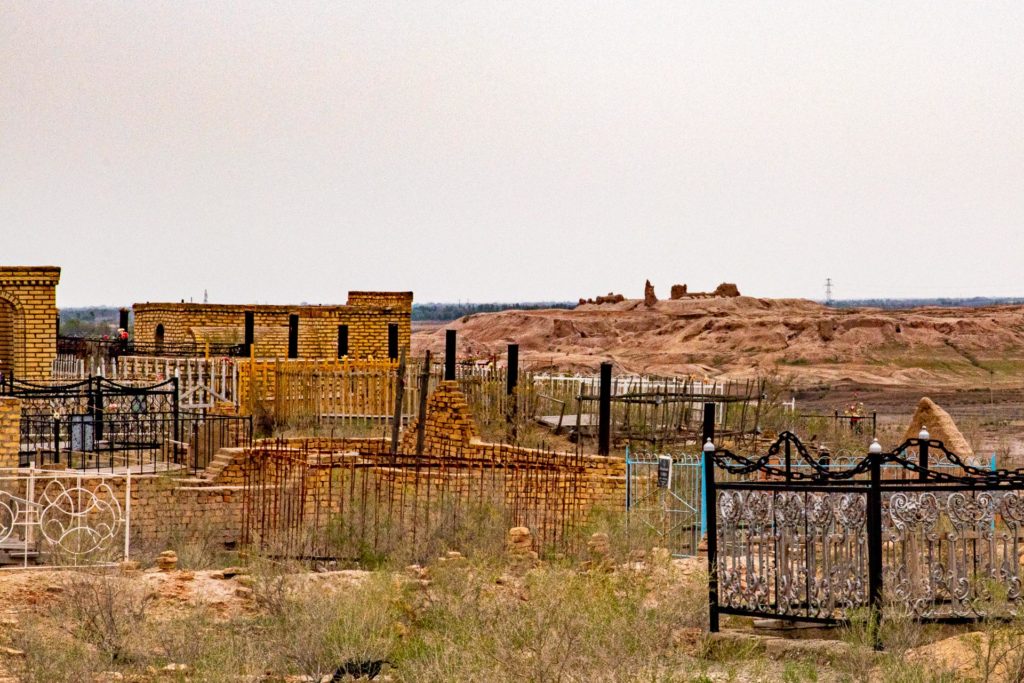
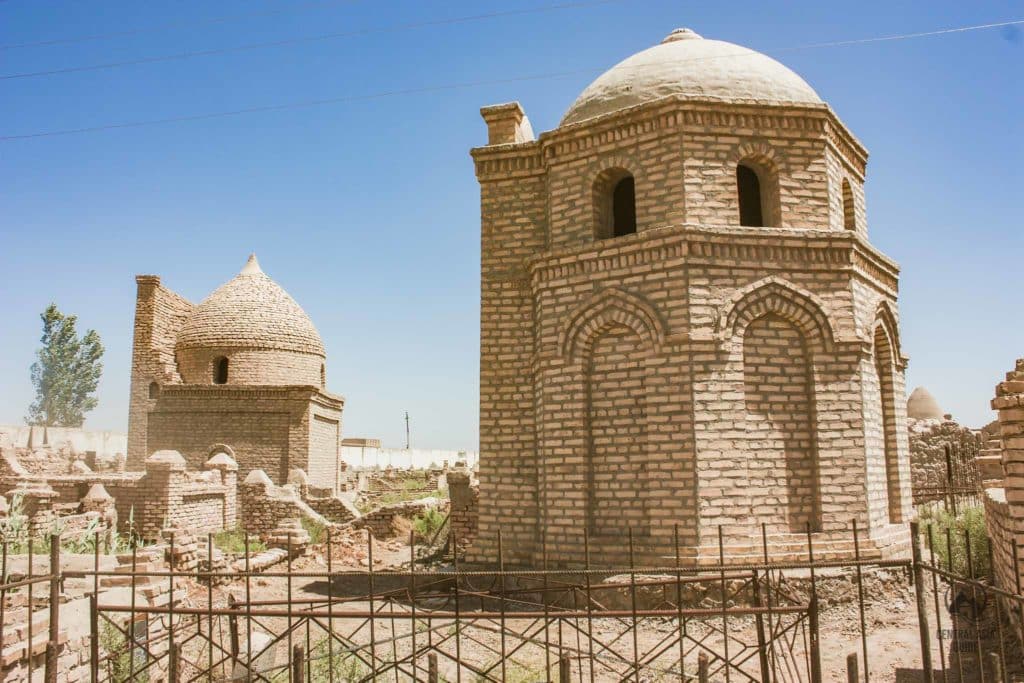
The Mizdakhan complex consists of several sections, including a citadel, a site outside the citadel walls, and a necropolis. The oldest settlement was founded on the western hill around the 4th century BC. The city was destroyed by fire, and in the Kushan period, a new one was erected on top of the old city. Artifacts found during excavations of the necropolis indicate that the city continued to be used from the 5th to the 8th centuries AD, and during this period new public buildings were built. In the period from the 9th to the 11th century, the city experienced a period of revival and a fortified citadel was built.
At the same time, the burial customs had changed, indicating the adoption of Islam in this region. The bodies were no longer left in the open air until buried in containers but were buried in the ground by the Muslim rites. New monumental tombs and mosques were built, however, at the beginning of the 13th century, Mongol invasions forced the population to leave the city for a short time. The medieval Mizdakhan was a flourishing center of handicraft production, which stood along the trade routes to and from Kunya-Urgench.
Mausoleum of Mazlumkhan-Sulu
The most impressive sight inside Mizdakhan is the restored Mausoleum of Mazlum Khan Slu which is also known as Mazlumkhon-Sulu, dating from between 12th and 14th centuries. This place is full of secrets and mysticism and some of the graves are open with fences around them, making them look like a zombie had gotten out from there!
Mazlumkhon-Sulu mausoleum, dating back to the 14th century is considered a typical cult multi-domed building, but its peculiarity is its division into two parts – above ground and underground. A small stone staircase leads deep into the underground part into the vast cross-shaped hall. It is cool here even in the daytime heat of fifty degrees and light from the dome windows is poured onto the mosaic walls with blue streams. The building has a cross-shaped plan, covered with three domes. The genesis of this architectural type is associated with the most ancient tent-roofed burial structures identified from the antiquities of the nomads of the South Aral Sea region, mounds Tagisken and the mausoleum of Balanda.
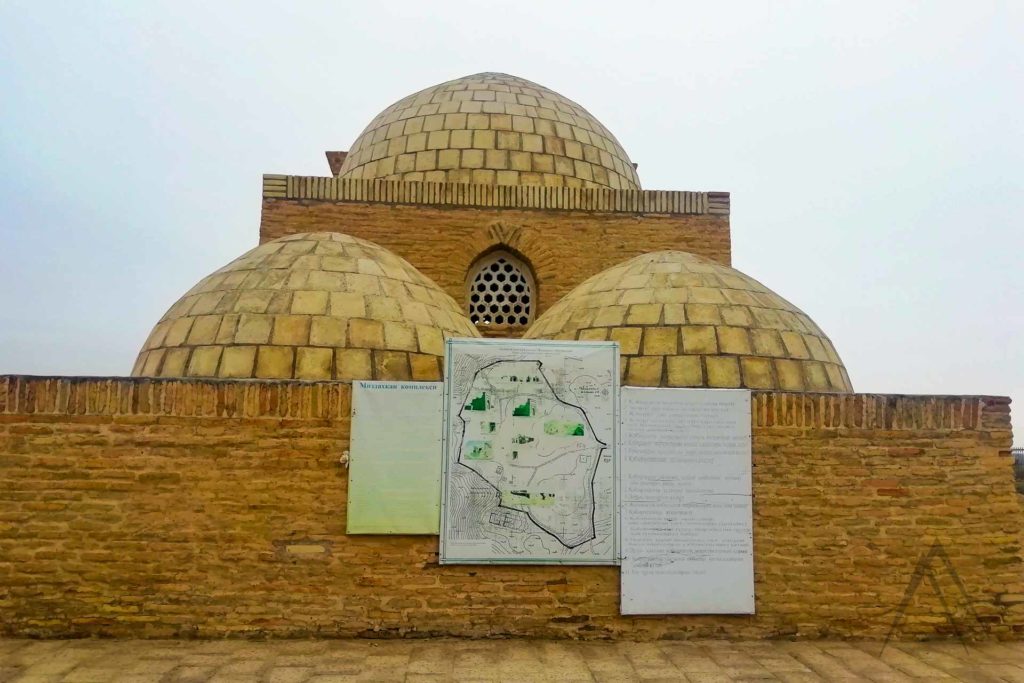
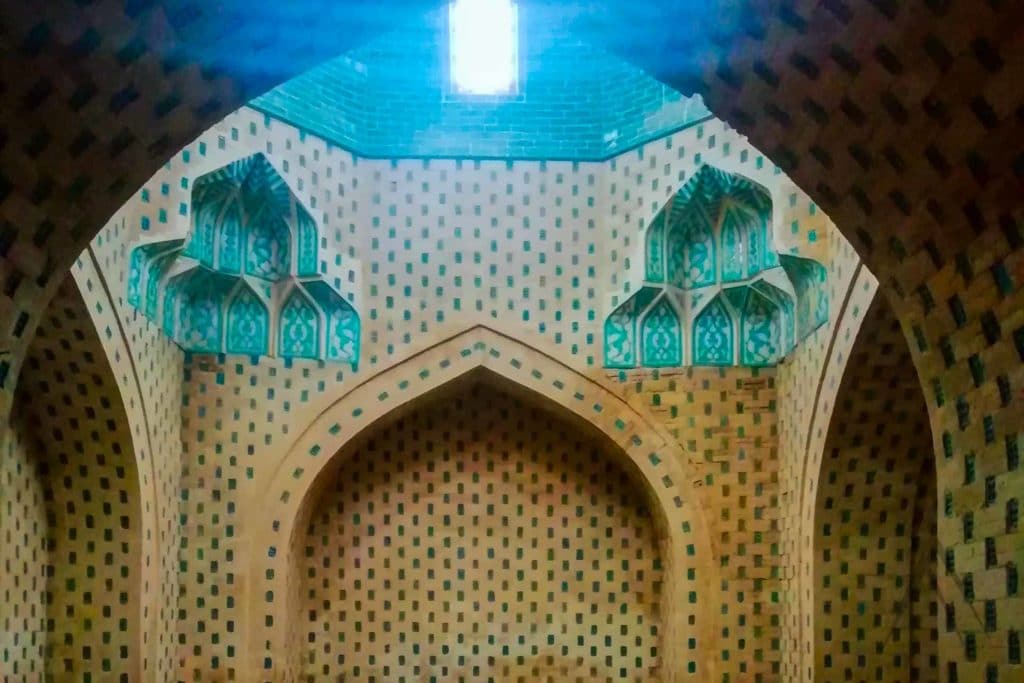
Mazlumkhan-Sulu Legend
According to the legend, the beautiful Mazlumkhon was the daughter of the ruler and her love was sought by the most notable and rich suitors. The girl nevertheless loved a simple architect who could not expect to marry a princess. Angered by the fact that his daughter rejects all the suitors in a row, the ruler announced that he would give her to marry someone who, overnight, would build a tower that was as high as the sky.
The enamored architect, inspired by luck, fulfilled this condition but still did not get the consent of her father. Then in grief, he rushed down from the minaret he had built himself with the princess following his fate. The governor repented and ordered to bury young lovers together and erect a mausoleum over their grave made of bricks of a minaret, which he desperately ordered to destroy and to bury deep into the earth.
Mausoleum of Shamun Nabi
The Shamun-Nabi mausoleum was originally built in the 13-14th century AD. The structure from fired brick is unusual due to its seven domes which is a very rare number for local architecture. Inside, in an unnaturally long sarcophagus – according to local legends – rests certain miracle-performer, maybe mystic, famous for his strength Shamun-Nabi.
The sarcophagus inside the mausoleum is 25 m long and – similar to the grave of Daniar in Samarkand which is said to be growing. After the coffin was opened in 1966, no human remains were found – the sarcophagus is actually empty!
There was a theory, that the real grave of Shamun-Nabi is close, at the place called “World clock” (where everybody can help preserve the world and grant it some additional minutes by putting 7 flat small stones into a pyramid); however, the excavations found a burial place of a woman there.
The original Shamun-Nabi mausoleum was demolished in 2018 with the sanction of the Ministry of Culture of Uzbekistan. Since it was not properly taken care of, the rain waters had weakened and flushed away parts of its walls. In 2016 a restoration team started its works on the object but stopped it due to a lack of perspectives to preserve the structure. In 2017 a semi-private company Meros chasması developed a project to construct a completely new structure to replace an old one and therefore the original unique domes have vanished.

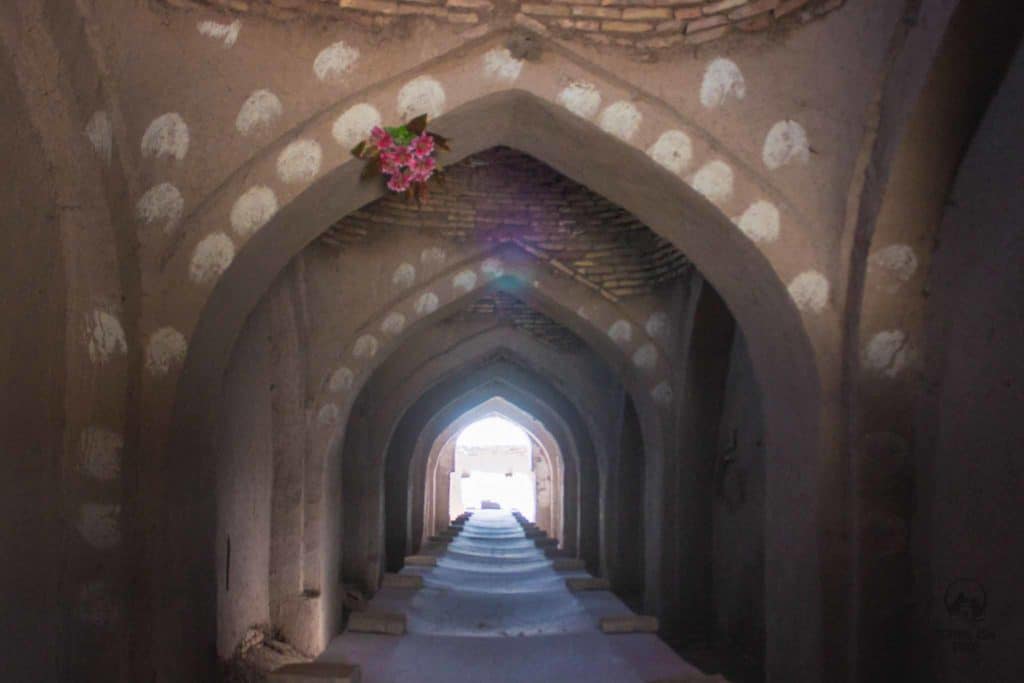
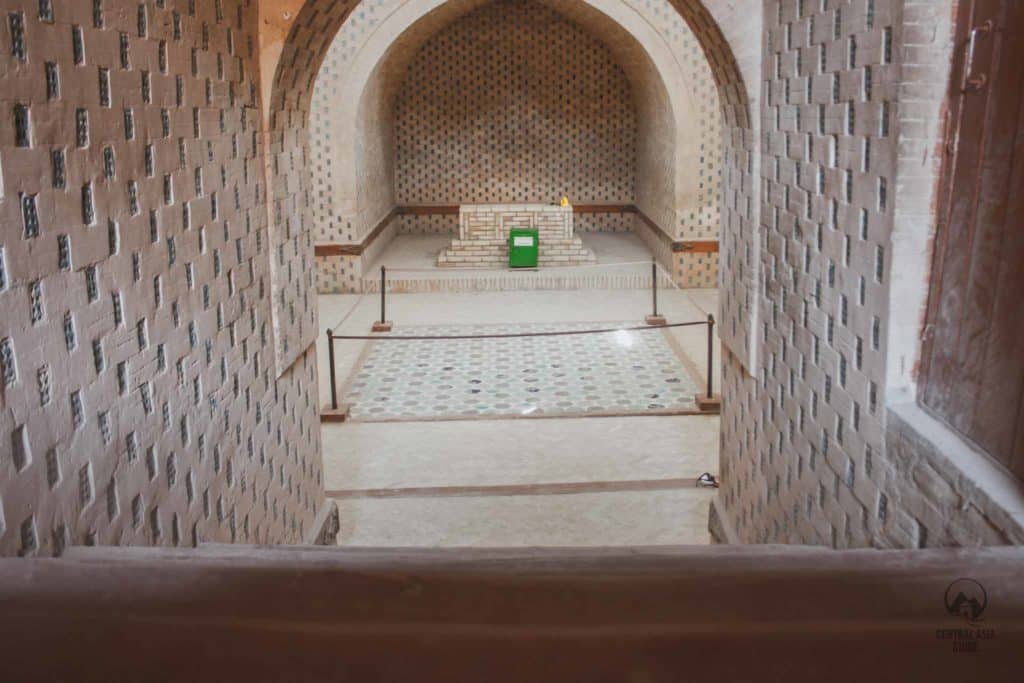
Shamun Nabi Legend
The legend says that Shamun-Nabi arrived here from Arabia long before the Prophet Mohammad was born, together with his brother Yahia. He settled on the same hill where the mausoleum now stands. Shamun preached belief in one God, understood the language of animals, could control the movement of stars, winds and rains, was healing the sick and foretold the future. He was living together with his wife and, wherever he went to, he was always accompanied by his dog. His archenemy, fierce polytheist Giaur, was living half a kilometer away, in a castle, known today as Giaur-Qala, and Shamun, constantly trying to convert Giaur into monotheism.
Shamun’s wife developed an affair with Giaur, who dug a tunnel, connecting his castle with Shamun’s house (it is said that some steps away from the mausoleum one can trace holes, last remnants of the buried entrance to the corridor). Once the holy man came home earlier and did not find his wife but found the tunnel and reached with it the room, where his wife was in flagrant with Giaur. He attacked his enemy, but his wife scattered some grains in front of him, so he slipped onto his knees and would be defeated, if not his dog, who jumped to the throat of Giaur and gave some precious time for his owner to regain strength. There are many versions of what happened afterward. Some say that the fight remained unsolved and Shamun went back home. His wife still wanted his death, but he could not be bound by anything she tried – all knots Shamun was able to tear away.
By chance, his evil wife knew that the only rope he is not able to destroy has to be woven from his hair taken from his beard. She prepared such a rope, bound her husband and asked Giaur to kill him. In this version, the holy man has risen from death and came to this world once again, to kill Giaur. Other say that Shamun killed Giaur, or that the dog did it, but the righteous man was so angry at his legs, which made him fall in front of his enemy, that at home he cut them away and died from blood loss. All admit, that he did not want to be buried with his treacherous legs.
Before his death, he took care of his fearless defender dog, who saved his life and ordered that a stone bowl should be placed at the entrance of his mausoleum, which served as a water source for the soul of his animal friend.
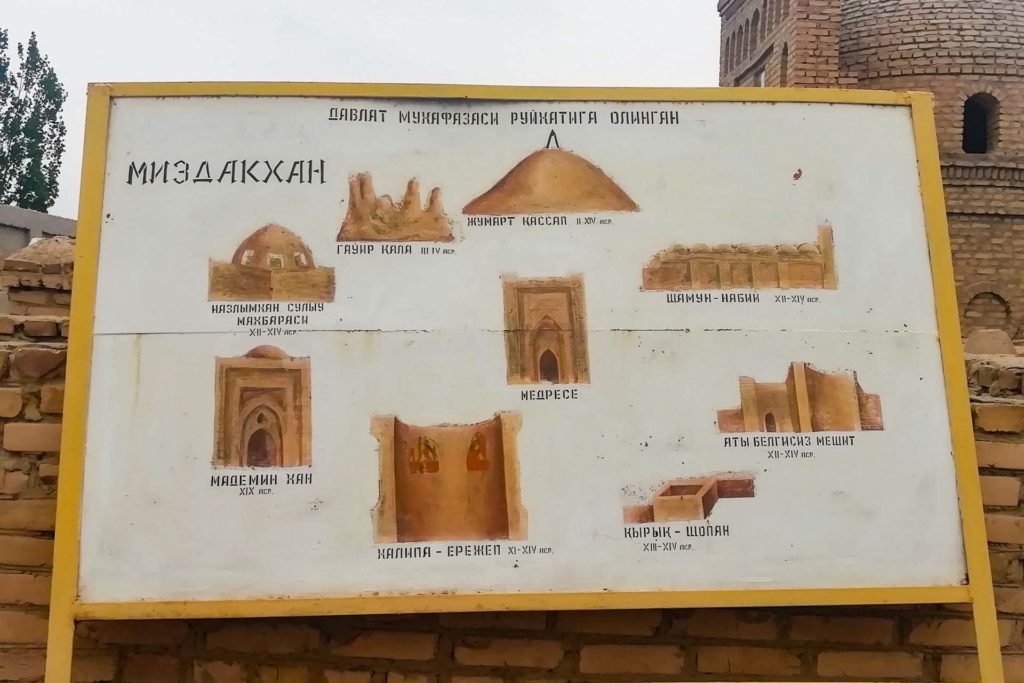
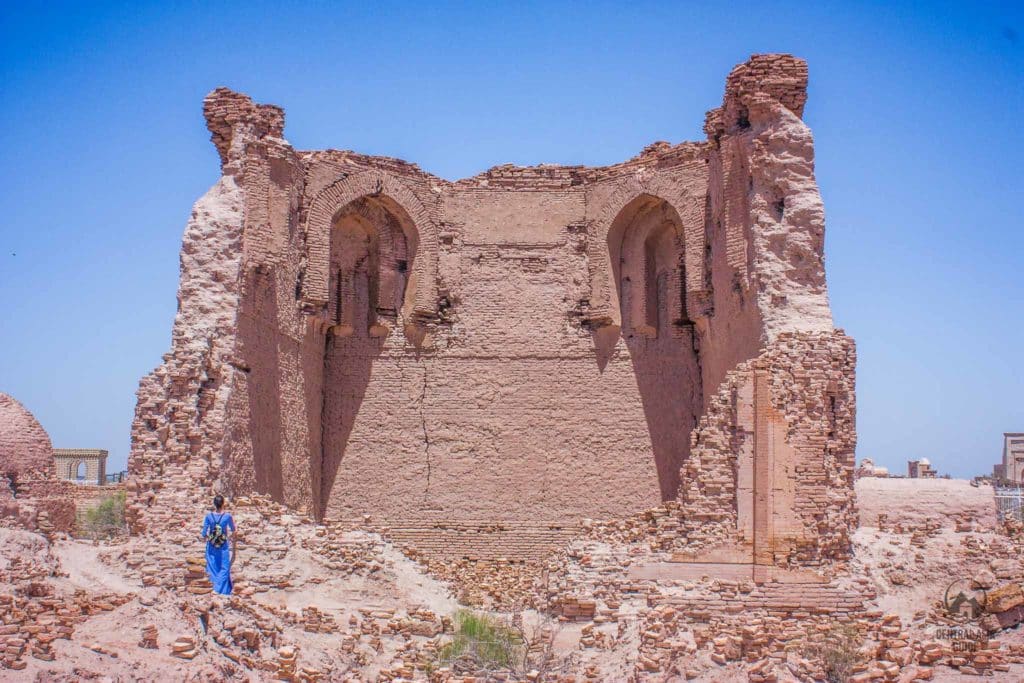
Mizdakan's Gyaur Kala
Mizdakan’s Gyaur Kala is located just about 1 km southeast on the road towards Turkmenistan border from the Mizdakhan complex at the outskirts of Khodjeyli town. This ancient clay fortress occupies a vast site of about 200 ha and it is situated on a similar kind of hill as the Mizdakhan cemetary and can be seen well from there too.
The ruins of majestic 10 meter high fortress walls appear along the edges of the steep cliffs of the hill. Within the walls, there are complex labyrinth-like remains of two castles dating back to various epochs. The earliest of them has also some intact remains of towers. Some archeologists believe that these towers were not only fortifications but also served as cult structures. The excavations in the other citadel exposed a large inner yard surrounded by ceremonial, dwelling and household quarters, decorated with paintings and clay carving. Facing the necropolis of Mizdakhan is the crumbled part of a huge arch that once was decorating the town’s gate. All over the area of the settlement, there are crumbled walls and roofs burying ancient constructions.
Gyaur Kala is not well known by local guides and tourists rarely visit it. The whole site is free to be roamed and ancient pieces of pottery can be seen scattered all around the fortress area. Watch out for buried households with weak roofs so that you do not fall inside the crumbling soil!
Destinations & sights near Mizdakhan
Page updated 27.1.2021
